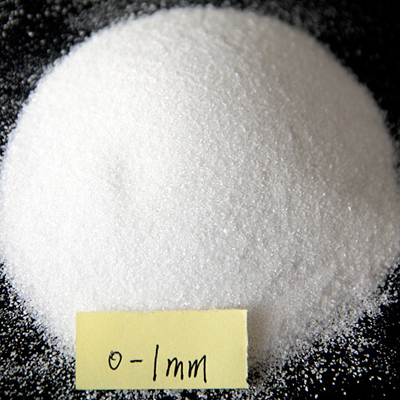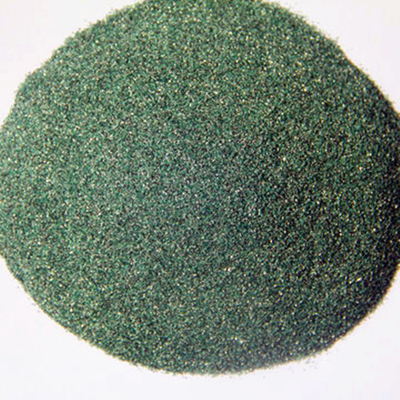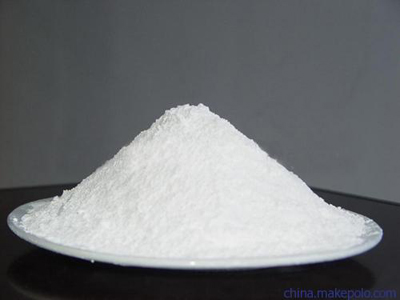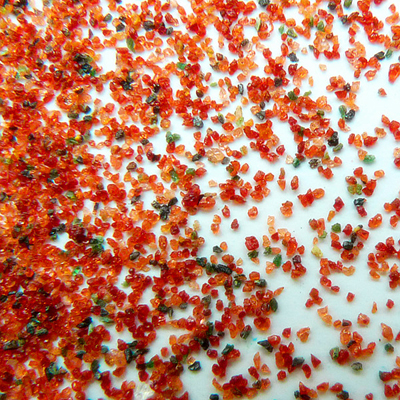
Aluminum oxide, silicon carbide, ceramics, and garnet are the four major types of sandpaper on the market. Each has a different use in the shop and it's useful to know how these abrasives work.
Aluminum oxide, silicon carbide, ceramics, and garnet are the four major types of sandpaper on the market. Each has a different use in the shop and it's useful to know how these abrasives work.
Aluminum oxide

Aluminum oxide is a sharp and blocky mineral. It is the most common, all-purpose woodworking abrasive, and for good reason. It is the only abrasive mineral that fragments under the heat and pressure generated by sanding wood. This characteristic is called friability and is highly desirable. As you sand, aluminum oxide renews its cutting edges constantly, staying sharp and cutting much longer than other minerals.
Aluminum oxide is also a relatively tough abrasive, which means that its edges won't dull much before they fragment. Its friability and toughness make aluminum oxide the longest lasting and the most economical mineral.
All aluminum oxides are not created equal. 3M alone manufactures 26 different kinds, ranging greatly in toughness and friability. The toughest grades are nearly white in their raw form and are used on premium-grade sand-papers. The softest grades are dark brown and more appropriate for sandblasting than sanding. Some cheap sandpapers have blast-grade aluminum oxide on them. No manufacturer is going to tell you which kind is on which sandpaper, however, and it's impossible to judge by the color of the sandpaper because a size coat covers and colors the mineral. If one brand's aluminum-oxide paper doesn't work well, don't judge all aluminum oxides by it. Simply try another.
Silicon carbide

Silicon carbide is black and iridescent, and the grains are shard-shaped. Unlike aluminum oxide, there is only one kind of silicon carbide. It is harder and sharper than most aluminum oxides, making it the better choice for cutting hard materials, such as finishes, paint, plastic and metal. Consequently, you'll probably find the widest range of silicon carbide sandpapers in a good auto-body supply store.
Silicon carbide sandpapers for woodworking are almost always on waterproof paper and intended for sanding finishes. Though silicon carbide is a friable mineral, it is so hard that sanding wood will not cause it to fragment and renew its cutting edges. Though it will sand faster at first, it will dull more quickly than aluminum oxide. It is also generally more expensive than aluminum oxide.
Ceramics

Ceramics come in a wide variety of shapes, from blocks and heavy wedges to flake-like shards. They're all more costly and less common than other abrasive minerals. All of them are very tough and very aggressive.
Like silicon carbide, ceramics are not friable, and do not renew their cutting edges when sanding wood. But they don't dull as quickly because of their extreme toughness. This makes them the best choice for hogging off stock, roughing out shapes, removing finish and leveling uneven boards. For this reason, they are generally available only in coarse-grit cloth belts for stationary and portable sanders.
Ceramic mineral names and the trade names they're sold under are not easy to sort out. Though Cubitron sounds like a trade name, it's a ceramic mineral. One of its trade names is Cubicut. When mixed with aluminum oxide, it's sold as Regalite. Alumina zirconia is the name of a ceramic mineral. Sometimes it's marketed as aluminum zirconia, as if it were another type of mineral. It's also sold under the trade names Norzon and AZ as a ceramic mineral.
Abrasive manufacturers make these names intentionally confusing to avoid losing their copyrights. If a trade name becomes synonymous with the product in the public's mind (think of a thermos), then any company can use it.
Garnet

Garnet is the only natural abrasive mineral still widely used for woodworking. Like aluminum oxide, it is blocky in shape. Unlike aluminum oxide, it is non-friable, not very tough and dulls very quickly. This is not necessarily a defect. The softer cut of a garnet paper, though slow, will produce the smoothest finish of all the abrasives within a given grit size. Because it is so soft, garnet will not leave pigtail-like scratches the way an aluminum oxide will when used on a random-orbit sander. This makes it well-suited for final sanding of wood surfaces.
Garnet is an excellent choice for final sanding end grain and blotch-prone wood. Garnet's peculiar tendency to burnish wood -- close off pores -- makes a stain penetrate far more evenly though less deeply.